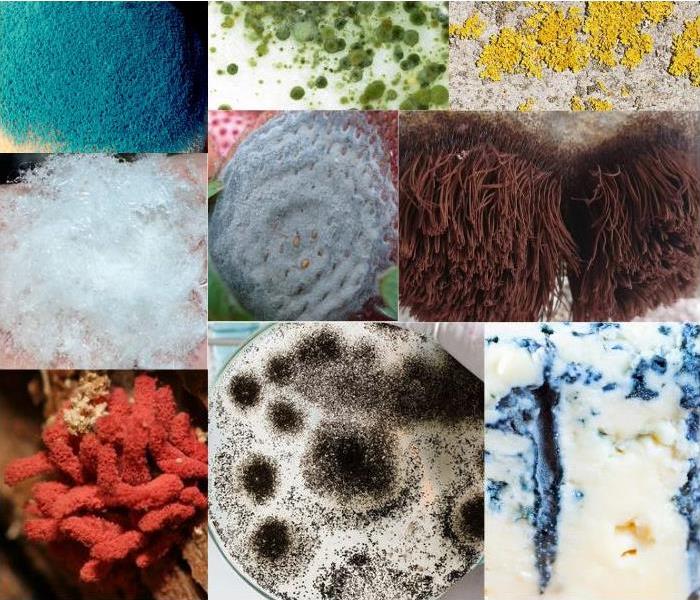What Makes Mold Different Colors?
2/11/2022 (Permalink)
Mold is a type of fungus that forms multicellular, thread-like structures and produces spores that give it its color. Mold is typically green, white, black or grey but can be brown, purple, orange, pink, yellow, red, white, or even a combination of colors. The color of mold can be influenced by many factors including food source, humidity level, light, region and even their age. The same mold can be different colors in different conditions and can even change over time.
Mold is typically multi-colored. This is because most types of mold appear with a small array of color or colors, ranging from white at the edges to a dark or bright color in the center. The colors are the spores themselves, the second surrounding color is the body, and the white or gray are the filaments that explore and produce spores. It is important to remember that the same mold type can appear in several different colors. This can make it very difficult to identify any particular type of mold by appearance alone.
Here’s some interesting facts about different colors of molds:
- Blue Mold can start out as blue and if the area keeps getting wet, eventually it can start to eat the blue mold and it will become black or green. This is why blue will not always stay blue and is usually pretty powdery. Blue mold is often found growing on food, but it can also be found growing on household materials like wallpaper, insulation, furnishings and carpeting that have been damaged by water.
- Gray Mold affects many plant species and greatly depends on the type of plant and environmental conditions.
- Orange Mold is unique and generally not a single type of species, but more like a colony of single-celled organisms. This mold may grow together with some other mold types, such as green mold or black mold, especially on food and usually appears with a slimy, spongy consistency. It is typically spotted eating rotted trees that have fallen in the woods and in mulch piles.
- Purple Mold is something that you can find behind walls, often underneath vinyl and wallpaper, and on wood. It mostly grows in areas hidden from plain sight.
- Brown Mold typically grows on plywood, other wood surfaces and in the bathroom on window sills or between tiles. It may look like fuzzy growth or small moist blobs.
- Pink Mold is controversial as some believe it is not a mold but instead is a bacteria. Science has proven that it is indeed both a mold and a bacteria. It is mostly found in moisture-rich environments like bathrooms where it can feed off soap and shower products and tends to be fuzzy
- Red Mold usually grows in tandem with other color molds. It grows on building materials such as particle board or drywall. It can also grow on spoiled food.
- White Mold is the default spore-free color of most molds and the exploratory tendrils of a mold are almost always white before they produce and release spores. This means that very new mold will almost always appear to be white. It can be found on virtually any material and thrives in dark and damp areas that include framing in the attic, basement walls, and exposed dirt in crawlspaces.
- Green Mold appears as soft and fuzzy or powdery and can have different hues of green. It can basically grow anywhere in your home where a water problem may occur. It loves latching onto food such as bread and starch heavy foods.
- Yellow Mold is a common household mold and can found virtually everywhere you’ve experienced water damage. It is sometimes referred to as house-eating mold because it feeds on wooden structures and literally eats away at them causing the deterioration of many old wooden buildings and wooden furniture.
- Black Mold favors materials, such as cardboard, hay, paper, wicker, and wood especially in humid rooms of a house.
Interested in learning other fascinating science facts about mold? Try searching “prettiest molds”, “slime molds” and even “bizarre fruiting bodies of slime molds!” This shows just how amazing nature is in our world.
The only time it is not interesting to learn about mold is when you learn you have unwanted mold growing in your home or business. Regardless of the color of your mold, you want it gone as soon as possible. That is when it is time to call SERVPRO of Toms River! Our highly trained technicians will remediate the mold with our Mold Remediation Process.




 24/7 Emergency Service
24/7 Emergency Service
